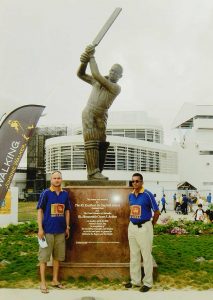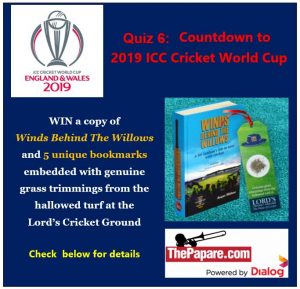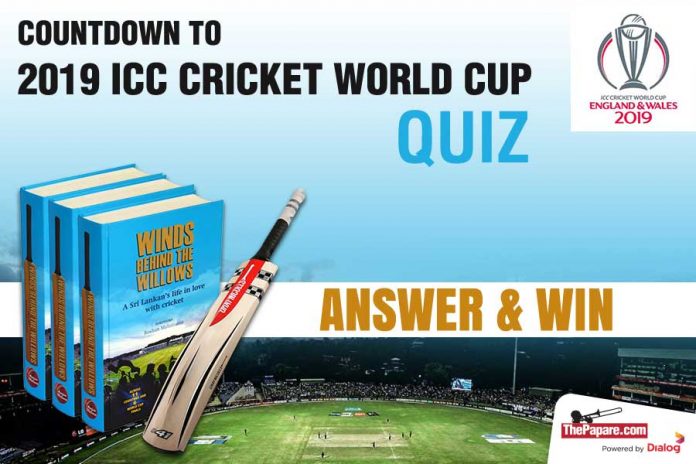When the covers finally came off, Ricky Ponting won the toss to a massive cheer and elected to bat. Considering the conditions, many felt it was a tricky decision and a good toss to lose. Soon after, there was another downpour. Play finally started at 12.15 pm, instead of the scheduled 9.30 am. Though there was a reserve day, as per the laughable playing conditions of this tournament, the late start meant a (reduced) 38-over game.
Why have a reserve day for a game, to be utilised only in the event of a carry-over, if each side cannot get 20 overs in? In contrast, the first World Cup final in 1975 was 60 overs a side; it began at 10.30 am and finished at 8.43 pm, in hot, sunny conditions in England.

Australia were circumspect at the start and after ten overs, were 46 without loss. The turning point in the match came in the 11th over. Dilhara Fernando dropped a caught and bowled chance, driven straight into his ankles, by Gilchrist on 31. The taking of difficult chances means a crack at victory. I instantly pictured the celebratory run of Bermuda’s 280lb Dwayne Leverock after taking a stunning diving slip catch to dismiss India’s Robin Uthappa earlier in the tournament. That catch revved up cricketers the world over and entered the ‘Hall of Fame’ of cricket World Cups.
In the 14th over, Gilchrist reached his third consecutive fifty in World Cup finals. Fernando nearly bowled Gilchrist in the 17th, but the opening pair added 100, the third 100-run stand for the first wicket in a World Cup final. These two did it against India in 2003, and Mike Brearley and Geoff Boycott added 129 against the West Indies in 1979.
Gilchrist reached his century off 72 balls and pointed to his glove when he celebrated the fastest hundred in the history of World Cup finals. He was dropped by a diving Kumar Sangakkara the very next ball. A tough chance off Lasith Malinga but…
Malinga finally broke the partnership in the 23rd over. Matthew Hayden was brilliantly held by Mahela Jayawardena at short extra cover. Hayden 38, Australia 172 for 1. Flag-waving and bugle-blowing exultant Sri Lankan fans replicated the Khettarama vibe for a few minutes. Thankfully, the ICC belatedly saw sense and lifted their absurd restrictions on these items during the latter stages of the tournament.
Holding his bat high, Gilchrist swung and connected all. His ferocious 149 off only 104 balls was the highest individual score in World Cup finals, beating Ricky Ponting’s 140 in 2003. It was also the highest score by a wicketkeeper-batsman in World Cups, beating Rahul Dravid’s 145 at Taunton in 1999.
Sri Lanka did not bowl that badly, nor were they untidy in the field, but Australia made 281 for 4 in their 38 overs. During the Australian innings, the Sri Lankans were not amused when both Ponting and Andrew Symonds were warned – but not penalised the dreaded 5 runs – for running on the pitch. Malinga had the best figures of 2 for 49.
After the early loss of Upul Tharanga in the third over, Sri Lanka progressed frenetically. The chase was on, with Sanath Jayasuriya’s pyrotechnics and Sangakkara throwing the bat in thrilling style. Sri Lanka were 102 for 1 in 16 overs (at 6.37), requiring a further 180 runs in 132 balls (22 overs at 8.18).

After 22 overs Sri Lanka were 139 for 2, 18 runs behind the Duckworth-Lewis par score. Jayasuriya followed soon after for 63 with a terrible slog off Michael Clarke, but the contest was by no means over.
The middle looked wet, the conditions windy and very gloomy. Rain intervened again at 5.10 pm, with Sri Lanka on 149 for 3 in 24.5 overs. When play resumed after the shower, no one in the ground knew whether or not and, if so, how the target had been reduced.
Jayawardena departed in the 26th over. Sri Lanka 156 for 4. Tillakaratne Dilshan slipped while setting off for a single and was run out in the 30th over. Sri Lanka were 188 for 5.
Australia, hampered by a wet ball, then delayed the proceedings and were booed for their slow over rate. In semi-darkness, Russel Arnold pulled a full toss above waist height, was caught behind and ruled out. The rest didn’t offer much resistance.
As the sun hid behind the clouds, it grew very dark. Sri Lanka, chasing a revised target of 269 off 36 overs, were 206 for 7 in 33 overs, well behind the Duckworth-Lewis target.
Though defiant, with an unattainable target staring at them, Sri Lanka finally accepted the umpires’ second offer of light, with three overs remaining.
Twenty overs had been completed by both sides, and as per the playing conditions of the tournament, Australia had won, and they began celebrating. After a few moments in silence to gather our thoughts, we dragged ourselves out of the ground. While we were walking on the adjoining road, to our shock, the giant screen inside the ground displayed an announcement that the match would recommence.
We were later informed that, amid great confusion, the umpires and the match referee had ruled that the match was not officially over. At least, not until the completion of the ‘balance’ of three overs, even if it meant players had to come back the next day.
In complete darkness, with both captains agreeing, those final three overs were bowled. Sri Lanka ended their stint at 215 for 8 after 36 overs, bringing a farcical conclusion to an ill-fated, ill-conceived tournament.
Australia retained the ICC Cricket World Cup 2007 by a margin of 53 runs (D/L method). Gilchrist was named Player of the Match, and Glen McGrath Player of the Tournament.
After 51 matches and seven weeks of competition, it was hard to believe that the ICC didn’t use common sense to stage a proper 50-over final. That would have made it a fair contest to decide the world champions. But for them, even to date, money from TV and sponsors are more important than the game itself. Be that as it may, for commercial success, sponsors and television channels would also want the ICC to ensure India’s presence at the business end. It can therefore be safely assumed that a modified format would apply for future World Cups after 2007.
(Adapted from ‘Winds Behind The Willows’.)




















